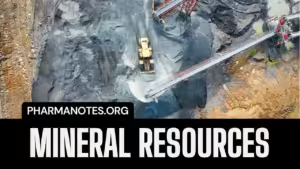Mineral Resources

Intended Learning Outcomes
At the end of this session, students will be able to
• Explain mineral Resources
• Discuss the use and exploitation of mineral Resources
• Describe the environmental effects of extracting and using mineral resources
Mineral Resources
• Mineral is a naturally occurring substance of definite chemical composition and identifiable physical properties
• An ore is a mineral or combination of minerals from which a useful substance, such as a metal can be extracted and used to manufacture a useful product
• Minerals are formed over a period of millions of years in the earth’s crust
• Iron, aluminum, zinc, manganese and copper are important raw materials for industrial use
• Important non-metal resources include coal, salt, clay, cement and silica
• Stone used for building material, such as granite, marble, limestone, constitute another category of minerals
• Minerals with special properties that humans value for their aesthetic and ornamental value are gems such as diamonds, emeralds, rubies
• Luster of gold, silver and platinum is used for ornaments
• Minerals in the form of oil, gas and coal were formed when ancient plants and animals were converted into underground fossil fuels
Mining
• Minerals and their ores need to be extracted from the earth’s interior so that they can be used, this process is known as mining
• Mining operations generally progress through four stages:
(1) Prospecting: Searching for minerals
(2) Exploration: Assessing the size, shape, location and economic value of the deposit
(3) Development: Work of preparing access to the deposit so that the minerals can be extracted from it
(4) Exploitation: Extracting the minerals from the mines
• Today, however, prospecting and exploration is done by teams of geologists, mining engineers, geophysicists and geochemists who work together to discover new deposits
• Modern prospecting methods include the use of sophisticated instruments like GIS to survey and study the geology of the area
• Mines are of two types – surface (open cut or strip mines) or deep or shaft mines
• Coal, metals and non-metalliferous minerals are all mined differently depending on the above criteria
• Most minerals need to be processed before they become usable
• Thus ‘technology’ is dependent on both the presence of resources and the energy necessary to make them ‘usable’
Mine safety
• Mining is a hazardous occupation and safety of mine workers is an important environmental consideration of the industry
• Surface mining is less hazardous than underground mining
• Metal mining is less hazardous than coal mining
• In all underground mines, rock and roof falls, flooding and inadequate ventilation are the greatest hazards
• Large explosions have occured in coal mines
• Mining poses several long-term occupational hazards to the miners
Environmental problems
• Mining operations are considered one of the main sources of environmental degradation
• Extraction of all these products from the lithosphere has a variety of side effects
• Depletion of available land due to mining, waste from industries, conversion of land to industry and pollution of land, water and air by industrial wastes are environmental side effects of the use of these non- renewable resources
• Public awareness of this problem is of a global nature and government actions to stem the damage to the natural environment have led to numerous international agreements and laws directed toward the prevention of activities and events that may adversel affect the environment
Summary
• Mineral is a naturally occurring substance of definite chemical composition and identifiable physical properties
• Minerals with special properties that humans value for their aesthetic and ornamental value are gems such as diamonds, emeralds, rubies
• Modern prospecting methods include the use of sophisticated instruments like GIS to survey and study the geology of the area
• Surface mining is less hazardous than underground mining
• Mining operations are considered one of the main sources of environmental degradation
Also, Visit:
B. Pharma Notes | B. Pharma Notes | Study material Bachelor of Pharmacy pdf